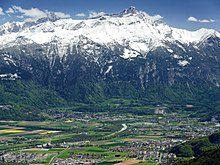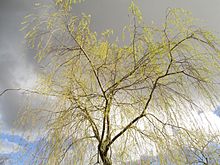Spring (season)
These were verbs meaning to rise up or to burst forth, (see also the modern German springen 'jump') and are not believed to have originally related to the season.
[1] Meteorologists generally define four seasons in many climatic areas: spring, summer, autumn (fall), and winter.
[4][5] In Sweden, meteorologists define the beginning of spring as the first occasion on which the average 24 hours temperature exceeds zero degrees Celsius for seven consecutive days, thus the date varies with latitude and elevation (but no earlier than 15 February, and no later than 31 July).
In the Northern Hemisphere (with countries such as Germany, the United States, Canada, and the UK),[12] solar reckoning was traditionally used with the solstices and equinoxes representing the midpoints of each season, however, the astronomical vernal equinox (varying between 19 and 21 March) can be taken to mark the first day of spring with the summer solstice (around 21 June) marked as first day of summer.
In the traditional Chinese calendar, the "spring" season (春) consists of the days between Lichun (3–5 February), taking Chunfen (20–22 March) as its midpoint, then ending at Lixia (5–7 May).
The phenological or ecological definition of spring relates to biological indicators, such as the blossoming of a range of plant species, the activities of animals, and the special smell of soil that has reached the temperature for micro flora to flourish.
[citation needed] In England, Wales and Northern Ireland, the National Trust runs the #BlossomWatch campaign, which encourages people to share images of blossom with one another, as an early indicator of the arrival of the season.
The hemisphere begins to warm significantly, causing new plant growth to "spring forth", giving the season its name.
Many flowering plants bloom at this time of year, in a long succession, sometimes beginning when snow is still on the ground and continuing into early summer.
[22] Many temperate areas have a dry spring, and wet autumn (fall), which brings about flowering in this season, more consistent with the need for water, as well as warmth.
While spring is a result of the warmth caused by the changing orientation of the Earth's axis relative to the Sun, the weather in many parts of the world is affected by other, less predictable events.
In North America, Tornado Alley is most active at this time of year, especially since the Rocky Mountains prevent the surging hot and cold air masses from spreading eastward, and instead force them into direct conflict.
Even more so than in winter, the jet streams play an important role in unstable and severe Northern Hemisphere weather in springtime.
The Passover begins on the 15th day of the month of Nisan, which typically falls in March or April of the Gregorian calendar on the night of a full moon after the northern spring equinox.







